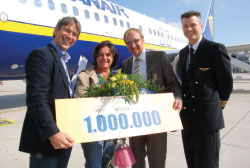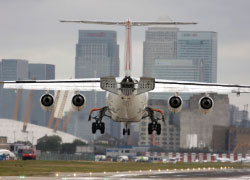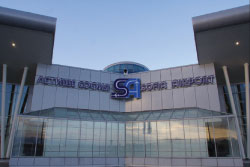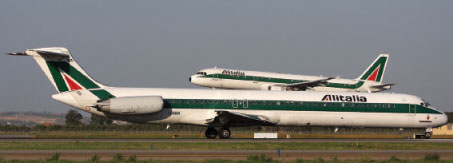
By Ralph Anker, Editor, anna.aero
A lot has been heard from airlines about how the rise in fuel costs, the so-called ‘credit crunch’, and the general downturn in most European economies has been bad for their business, but rather less has been heard from airports. Which of the hundreds of airports across Europe has been hit hardest by recent events and which have been able to buck the trend for whatever reason? This article looks at traffic trends from May to August. February, March and April are misleading for year-on-year comparisons as February had an extra day while Easter shifted from April to March causing significant shifts in demand.
French traffic has grown throughout summer period

Ryanair’s selection of Weeze as its third German base has boosted that airport’s traffic by more than 60% this summer. In September, Airport Weeze celebrated handling one million passengers in a year for the first time. The millionth passenger was Heleen M. Koppens, who arrived on a Ryanair flight from Alicante.
Of nine major European countries for which data is readily available only in France has total airport traffic been positive in each of the four months examined. All other countries have had at least one month when total airport traffic was down compared with the previous year. Things have been worst in Europe’s two largest airport markets, Spain and the United Kingdom. In June, July and August total airport traffic in these two countries fell by between 1% and 4% respectively.
In Spain, some of this can be attributed to the launch of high-speed rail services earlier this year between Madrid and Barcelona which has seen air traffic on Europe’s busiest air route fall by around 30%. Other factors include an economic slowdown and the decision by previously fast-growing Vueling to reduce its fleet, axe routes and increase fares.
Even where airlines have not cut capacity or flights the average load factor of most major airlines (including the leading low-cost carriers) has been down as many airlines have increased their fuel surcharges and added other fees to try and recoup the losses many are currently suffering from. This increase in fares has, not surprisingly, had an impact on demand.

In the UK, where the decline in traffic at some 20 airports has resulted in an overall reduction this summer, London City reported double-digit growth of +13%.
Winners…
Within countries the performance of individual airports has varied considerably. In the UK, where the decline in traffic at some 20 airports has resulted in an overall reduction this summer, Newquay (+40%), Belfast City (+27%) and London City (+13%) have all reported double-digit growth. In Spain where summer traffic was down at 23 airports, Zaragoza (+24%), Girona (+13%) and Santander (+12%) also saw significant traffic increases.

Airports across Europe that have reported traffic growth of more than 20% this summer include Sofia, Paris Beauvais and Stockholm Skavsta, plus three airports in Poland – Katowice, Poznan and Wroclaw.
Across Germany traffic growth faltered from a respectable 5% in May to under 1% in July before finally falling 1% in August. Traffic was down this summer at nine airports including Frankfurt and Stuttgart. However, at smaller regional airports such as Weeze, Saarbrucken and Karlsruhe/Baden-Baden traffic growth has been impressive.
Ryanair’s selection of Weeze as its third German base has boosted that airport’s traffic by more than 60% this summer. Dortmund has seen double-digit traffic growth this summer but will be hampered this winter by the loss of several easyJet routes as the airline closes its base there.
Alitalia’s woes have not impacted Italian airports as much as might have been expected. The decision to ‘de-hub’ Milan Malpensa and move services to Rome Fiumicino has resulted in Malpensa’s traffic being down over 20% this summer. However, passenger numbers at Fiumicino have been up around 13%. An impressive 12 airports have still reported double-digit growth this summer including Verona Brescia (+60%), Forli (+20%) and Milan Bergamo (+16%). Ryanair’s decision to make both Forli and Bologna bases in the next few months, plus easyJet’s on-going expansion at Malpensa will continue to benefit Italian consumers.

Alitalia’s woes have not impacted Italian airports as much as might have been expected. The decision to ‘de-hub’ Milan Malpensa and move services to Rome Fiumicino has resulted in Malpensa’s traffic being down over 20% this summer. However, passenger numbers at Fiumicino have been up around 13%.
Other airports across Europe that have reported traffic growth this summer of over 20% include Paris Beauvais, Sofia and Stockholm Skavsta, plus three airports in Poland – Katowice, Poznan and Wroclaw. Poland is still benefiting from its entry to the EU in May 2004 and the flexible labour laws that have encouraged workers to migrate (maybe only temporarily) to Ireland and the UK in particular.
… and losers
At least 80 airports across Europe have seen traffic drop during the key summer period. Those where traffic has fallen by more than 20% include Jerez de la Frontera, Leon, Pamplona and Vitoria in Spain, Molde in Norway, Strasbourg in France, Coventry in the UK and Jonkoping in Sweden, plus the previously mentioned Milan Malpensa.
Strasbourg has suffered from the launch of TGV services from Paris which began last summer. This resulted in air traffic to Paris falling by over 50%. Since the Paris route represented around half of the airport’s total traffic passenger numbers are down around 25%. Vitoria, where traffic is down almost 70% has suffered from the axing of two Ryanair routes to Dublin and London Stansted. This proves that while LCCs can be great for boosting traffic in the short-term, routes will only survive if they are viable in the long-term.
Intra-European capacity down almost 6% in the final quarter of 2008
If airlines have struggled to make money this summer then this winter may determine if some carriers even survive into 2009. Even Ryanair is concerned about its short-term profitability and has taken the decision to ground several aircraft this winter at its Dublin and Stansted bases as well as ceasing operations at seven airports across Europe from early November to mid-December.
According to the latest analysis of fourth quarter capacity by OAG, seat capacity on intra-European routes is 5.6% lower than it was a year ago. Just two months ago OAG estimated that intra-European capacity would be down just 2.8%. The doubling of the expected reduction in just two months shows that the short-term outlook is set to be challenging for airlines and airports alike.







